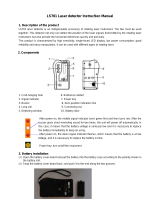AccuLine PRO 40-6515 User manual
- Category
- Laser levels
- Type
- User manual
This manual is also suitable for
AccuLine PRO 40-6515 is a self-leveling rotary laser level that can project both horizontal and vertical laser planes. It features a magnetic dampening compensation system to ensure accuracy and stability. The laser has a range of up to 1,650 feet (500 meters) and can rotate at speeds of 200, 400, and 600 RPM. The AccuLine PRO 40-6515 is water and dust resistant, making it ideal for use in both indoor and outdoor applications. It comes with a soft-sided carrying case for easy transport and storage.
AccuLine PRO 40-6515 is a self-leveling rotary laser level that can project both horizontal and vertical laser planes. It features a magnetic dampening compensation system to ensure accuracy and stability. The laser has a range of up to 1,650 feet (500 meters) and can rotate at speeds of 200, 400, and 600 RPM. The AccuLine PRO 40-6515 is water and dust resistant, making it ideal for use in both indoor and outdoor applications. It comes with a soft-sided carrying case for easy transport and storage.




















-
 1
1
-
 2
2
-
 3
3
-
 4
4
-
 5
5
-
 6
6
-
 7
7
-
 8
8
-
 9
9
-
 10
10
-
 11
11
-
 12
12
-
 13
13
-
 14
14
-
 15
15
-
 16
16
-
 17
17
-
 18
18
-
 19
19
-
 20
20
-
 21
21
-
 22
22
-
 23
23
-
 24
24
AccuLine PRO 40-6515 User manual
- Category
- Laser levels
- Type
- User manual
- This manual is also suitable for
AccuLine PRO 40-6515 is a self-leveling rotary laser level that can project both horizontal and vertical laser planes. It features a magnetic dampening compensation system to ensure accuracy and stability. The laser has a range of up to 1,650 feet (500 meters) and can rotate at speeds of 200, 400, and 600 RPM. The AccuLine PRO 40-6515 is water and dust resistant, making it ideal for use in both indoor and outdoor applications. It comes with a soft-sided carrying case for easy transport and storage.
Ask a question and I''ll find the answer in the document
Finding information in a document is now easier with AI
Related papers
Other documents
-
Johnson Level 99-026K Operating instructions
-
Johnson Level 40-6184 Owner's manual
-
ADA INSTRUMENTS A00497 User manual
-
 Tavool T04 User manual
Tavool T04 User manual
-
ADA INSTRUMENTS А00239 2D Basic Level Line Laser User manual
-
Johnson Level 40-6164 Owner's manual
-
ADA INSTRUMENTS А00545 Cube 3D Green Line Laser User manual
-
ADA INSTRUMENTS А00572 Cube 3-360 Line Laser User manual
-
 LAISAI LS701 User manual
LAISAI LS701 User manual
-
ADA INSTRUMENTS А00472 ProLiner 2V Line Laser User manual

























